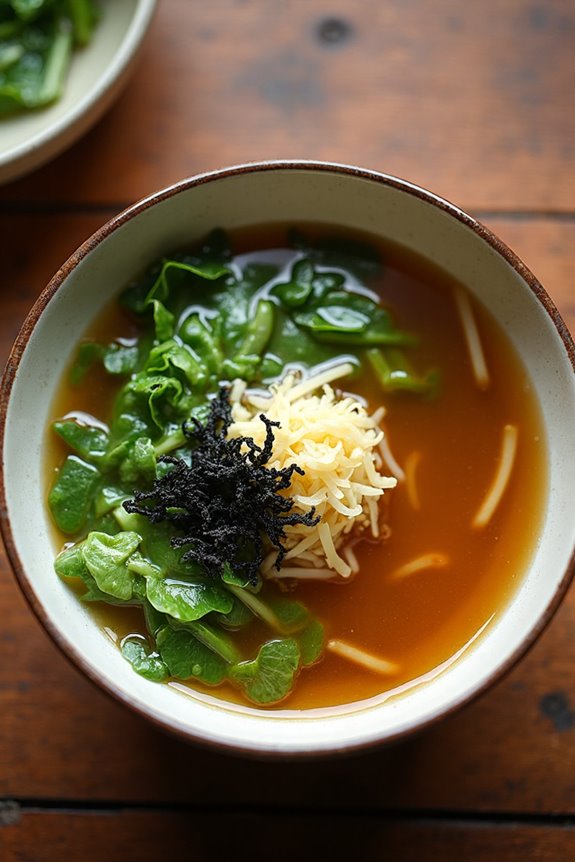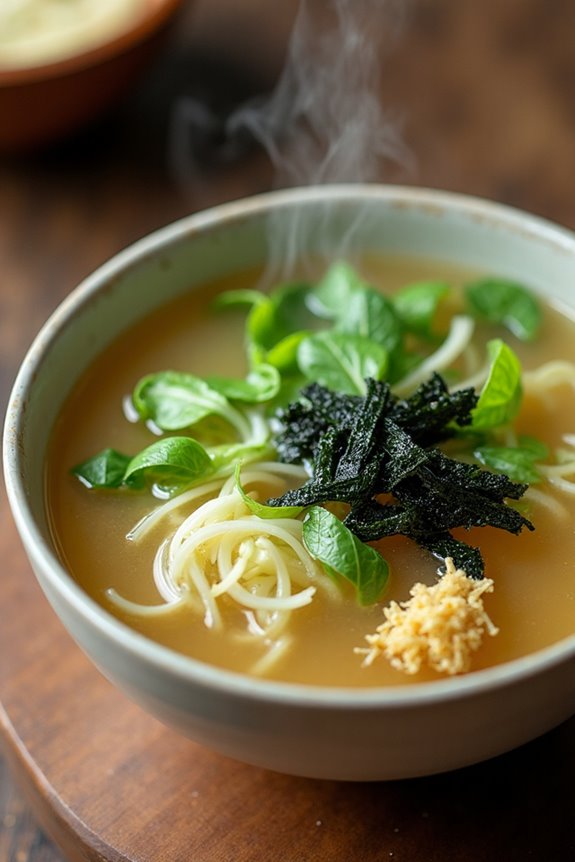Links below are affiliate links. We earn a commission on purchases at no extra cost to you.
Comforting Japanese Miso Soup Recipe From Scratch
Knowing how to make comforting Japanese miso soup from scratch will transform your kitchen into a cozy haven—discover the secret to its perfect balance.

Why You’ll Love this Comforting Japanese Miso Soup
Soup has this magical way of wrapping you in warmth, and miso soup? It’s like a cozy hug in a bowl.
You get this perfect balance—earthy, salty, with a hint of sweetness that just makes your taste buds sit up and pay attention. It’s light yet satisfying, so it never feels like you’re overdoing it.
Plus, it’s surprisingly quick to whip up, even if you’re juggling a million things. The subtle layers of flavor sneak up on you, making every sip feel like a tiny celebration.
And let’s be honest, who doesn’t want a soup that feels fancy but won’t keep you stuck in the kitchen for hours?
It’s comfort food that respects your time and your appetite. Simple, soothing, and downright addictive.
What Ingredients are in Comforting Japanese Miso Soup?
Alright, let’s talk ingredients—the heart and soul of this comforting Japanese miso soup. It’s surprisingly simple but packs a punch with each component. The beauty here is how a few humble ingredients come together to create something that’s cozy, flavorful, and totally satisfying.
You don’t need a pantry full of exotic stuff, just a handful of key players that bring that authentic vibe to your bowl.
Here’s what you’ll need to get started:
- 3 inches wakame seaweed strip (pre-soaked)
- 1 tablespoon miso paste
- 1 handful watercress, finely chopped
- 2 leaves Chinese cabbage, finely chopped
- 2 sheets nori seaweed, cut into fine strips
- 1/2 teaspoon grated ginger
- 4 cups water
Now, these ingredients aren’t just thrown together randomly. Wakame and nori bring those deep umami sea flavors, grounding the soup in that classic Japanese taste.
Miso paste is the real MVP, giving the broth its signature savory richness. Fresh watercress and Chinese cabbage add a subtle crunch and freshness that keeps the soup lively, while ginger sneaks in a gentle zing to warm things up.
Plus, water is obviously the base, but quality counts—using filtered water can make a subtle difference. Remember, the seaweed needs a quick soak to rehydrate it just right, so keep an eye on that.
Simple, fresh, and totally doable without making you feel like you’re on a culinary scavenger hunt.
How to Make this Comforting Japanese Miso Soup

Making a comforting bowl of Miso Soup is surprisingly simple, yet it feels like a warm hug on a chilly day.
First things first: take those 3 inches of wakame seaweed strips and give them a quick 2-minute soak in a bowl of water. It’s like waking up your seaweed friends before they join the soup party.
Meanwhile, bring 4 cups of water to a boil in a pan—once it’s bubbling, lower the heat to a gentle simmer. Toss in the wakame and let it hang out for about 3 minutes, soaking up the warmth and flavor.
Now, here’s a neat little trick: take 1 tablespoon of miso paste and mix it with 2 tablespoons of cold water in a cup, diluting it so it blends smoothly into the soup without clumps.
Add this miso mixture to your simmering pot and stir gently—no need to boil it, just a gentle 1-minute simmer to keep those probiotics happy.
Next up, chop up a handful of watercress and 2 leaves of Chinese cabbage finely, then stir them into the pot and turn off the heat. The vegetables will soften just right in the hot broth without getting mushy.
Serve your miso soup with strips of nori seaweed and a tiny sprinkle of 1/2 teaspoon grated ginger for that subtle zing.
You’re left with a bowl that’s light, flavorful, and downright soothing. Who knew simple ingredients could create such magic?
For an authentic cooking experience, consider using a Filipino cooking appliance set to prepare your ingredients efficiently and with ease.
Comforting Japanese Miso Soup Substitutions and Variations
Even though traditional miso soup has a pretty straightforward ingredient list, swapping things around can turn it into a whole new experience without losing that cozy vibe.
For instance, if you’re out of wakame, try spinach or kale for a leafy twist. Want a protein boost? Silken tofu cubes slide in perfectly, adding creaminess without stealing the show.
Don’t have Chinese cabbage? Napa cabbage or even bok choy work just as well. Miso paste comes in varieties like white, yellow, and red—each brings a different depth, so try mixing them up for fun.
And if ginger isn’t your thing, a dash of garlic or a sprinkle of green onions livens things up. The point? Feel free to experiment; miso soup is forgiving and endlessly comforting.
What to Serve with Comforting Japanese Miso Soup
When you’re serving up a comforting bowl of miso soup, pairing it with the right dishes can turn a simple meal into something special.
Think light and fresh—steamed rice is a no-brainer, soaking up that savory broth like a champ. Add a side of pickled vegetables for a tangy crunch that wakes up your taste buds.
If you want to get a bit fancy, a small plate of grilled fish or teriyaki chicken complements the soup’s delicate flavors without stealing the spotlight. Don’t forget a handful of edamame for a fun, finger-food vibe.
And hey, if you’re feeling adventurous, a simple cucumber salad with sesame oil can bring a revitalizing twist.
It’s about balance—soft, crunchy, warm, cool—all working together in harmony.
Final Thoughts
Although miso soup might seem simple, it’s a dish that deserves a bit of respect for its balance and subtlety. It’s not just about throwing ingredients together; it’s about timing, gentle simmering, and that perfect whisk of miso paste.
You’ve got the umami-rich wakame, crisp watercress, and a zing of ginger—all playing together harmoniously. Don’t rush it. Miso soup is like a quiet conversation—soft, comforting, but packed with meaning.
And hey, if you spill some miso paste or over-simmer the wakame, it’s not the end of the world. Just tweak and try again.
Once you get it, this humble bowl becomes a little ritual, a warm hug on a chilly day. Trust me, your taste buds will thank you.






